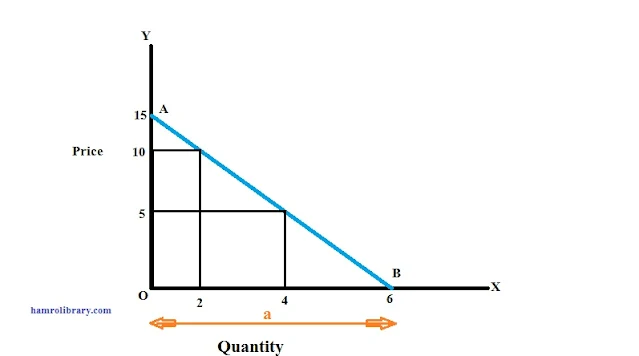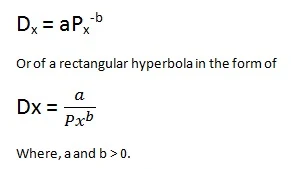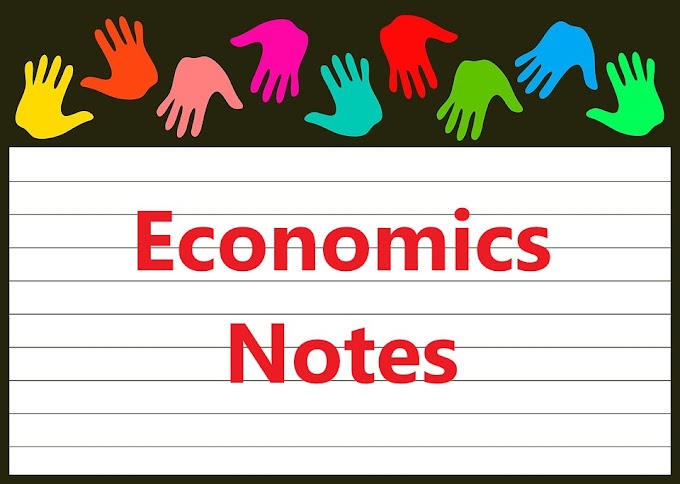Meaning of Demand:
In the ordinary sense, demand and desire are used as synonyms. But in economics demand implies more than desire. The demand for a commodity is its quantity which consumers are able and willing to purchase at it each possible price during a given period of time, other things remaining the same.
A beggar’s desire to have a car has no significance as he cannot pay for it. On the other hand, a rich businessman's desire to buy a car is his demand as he is able to pay for it and willing to do so. Thus, demand is a desire for a commodity backed by ability and willingness to pay.
Therefore, both ability and willingness to pay are essential elements for demand. If a man is willing to pay but he is unable to pay, his desire will not be demand. In the same way, if he is able to pay but is not willing to pay, his desire will not change into demand. In order to change desire into demand, it is essential that he should have both willingness and ability to pay. Thus, a desire accompanied by ability and willingness to pay makes a real or effective demand.
According to Marshall, “Demand refers to the quantities of a commodity that the consumers are able and willing to buy at each possible price during a given period of time other things being equal.”
In the words of Bober, “By demand, we mean the various quantities of a given commodity or service, which consumers would buy in one market in a given period of time at various price.”
In simple words, demand means the number of goods and services which a consumer would buy in a market at a given price and time periods.
A beggar’s desire to have a car has no significance as he cannot pay for it. On the other hand, a rich businessman's desire to buy a car is his demand as he is able to pay for it and willing to do so. Thus, demand is a desire for a commodity backed by ability and willingness to pay.
Therefore, both ability and willingness to pay are essential elements for demand. If a man is willing to pay but he is unable to pay, his desire will not be demand. In the same way, if he is able to pay but is not willing to pay, his desire will not change into demand. In order to change desire into demand, it is essential that he should have both willingness and ability to pay. Thus, a desire accompanied by ability and willingness to pay makes a real or effective demand.
According to Marshall, “Demand refers to the quantities of a commodity that the consumers are able and willing to buy at each possible price during a given period of time other things being equal.”
In the words of Bober, “By demand, we mean the various quantities of a given commodity or service, which consumers would buy in one market in a given period of time at various price.”
In simple words, demand means the number of goods and services which a consumer would buy in a market at a given price and time periods.
Types of demand
Demand may be broadly classified into different types, which are as follows:
1. Direct Demand
The demand for the ultimate object is called direct demand. In other words, direct demand refers to the demand for a commodity that is directly consumed to Satisfy human wants. For example, demand for bread, butter, fruits, etc. Direct demand for a commodity can be further classified into price demand, income demand, and cross demand.
a. Price demand: Price demand refers to the various quantities of a commodity or services that a consumer would purchase at a given time period in the market at various prices. It expresses the relationship between price and quantity demanded. There would be higher demand at a lower price and lower demand at a higher price, other things remaining the same. Consumer's income, his tastes, and preferences, price of a related good, are the other thing s.
b. Income demand: Income demand expresses the relationship between the income of a consumer and demand for a commodity. It refers to the various quantities of goods and services, which would be purchased by a consumer at various levels of income in a given period of time other things being equal. Other things are the prices of the related goods, taste, and preferences, price of the same good, etc. The demand for normal goods increases with the rise in income and vice versa. But in the case of inferior goods, there is an inverse relationship between income and demand. In such a case, as income increases demand decreases and vice versa.
c. Cross demand: Cross demand expresses the relationship between the demand for one good, say X, and the price of the related good, say Y. It refers to the various quantities of a good, which will be purchased with reference to the change in the price of other related goods. There are two types of related goods: substitute and complementary.
i. Substitute goods: Those goods are substitute goods, which are used in place of each other, for example, tea and coffee. If the price of tea increases the demand for coffee will rise and vice-versa, the price of tea remaining the same.
ii. Complementary goods: Those goods are complementary goods, which are jointly used to satisfy a want, for example, pen and ink. In such a case, the rise in the price of pens will bring a fall in the demand for ink. Conversely, a fall in the price of pens will increase the demand for ink.
2. Indirect Demand or Derived Demand
Indirect demand is also called derived demand. Demand for factors of production, which go to make the final product is called indirect or derived demand because they help in the production of a commodity, which is directly demanded by the consumer in the market. For example, demand for brick, cement, iron, wood, labor, etc. to construct a building is derived demand.
3. Joint Demand
When several things are demanded for a joint purpose, it is a case of joint demand. In other words, the demand for complementary goods is joint demand because complementary goods are demanded jointly to Satisfy a want. For example, demand for a car and petrol, pen and ink, etc.
4. Composite Demand
When a good is demanded for several uses, it is called composite demand. For example, demand for electricity is composite demand because it has several uses like heating, cooling, lighting, etc.
5. Competitive Demand
Goods that are close substitutes with each other are said to be in competitive demand. Other things being equal, the demand for a good will change when the price of its substitute changes. For example, demand for NTC mobile and NCell mobile is competitive demand.
Click here to learn about "The Law of Demand"
Exceptions to the Law of Demand
According to the law of demand, at the lower price, more quantities of a commodity are demanded and at the higher price, fewer quantities are demanded. But this law does not apply in every case and situation. The situations, when the law of demand does not hold are known as exceptions to the law. Some of the exceptions are as follows:
1. Expectations regarding future price: When consumers expect a rise in the price of a durable commodity, they buy more of it despite rising in its price. Similarly, when consumers expect a further fall in the price, they postpone their purchase, as a result, demand decreases.
2. Prosperity and depression: At the time of general prosperity, people buy more even when the price goes up. It is due to the increase in purchasing power of the consumers. On the other hand, during the depression period, despite the fall in price, the demand for things also decreases. This is because of the fall in purchasing power of consumers.
3.Giffen goods: Giffen goods are those goods, which are demanded more at a higher price and less at a lower price. In other words, the price effect is positive and the income effect is negative in the case of Giffen goods. Most poor households consume these goods. If the price of such goods increases, their demand will increase instead of decreasing. For example, suppose the monthly minimum consumption of food grains by a poor household is 30 kg including 20 kg millet (a Giffen good) and 10 kg of rice (a superior-good). Suppose that price per kg of millet is Rs. 30 and rice is Rs. 40. At these prices, the household spends Rs. 1000 per month on food grains. As the price of millet increases to Rs. 40, the household will be forced to reduce the consumption of rice and increase the demand for millet in order to meet its minimum monthly consumption requirement within Rs,1000 per month. In this situation, millet is a Giffen good.
4. Ignorance: If the consumer is not aware of the competitive price of the commodity, he purchases more of the commodity even at a higher price. It may also be due to the phobia that high-priced commodities are always superior in quality. Such attitude and ignorance of the consumer make the law of demand ineffective.
5. Change in fashion, habit, and preferences: Change in such behavior of the consumer is also responsible for making the law of demand ineffective and not working.
6. Prestigious goods (Veblen Goods): The law of demand does not apply to the commodities, which serve as a status symbol, enhances social prestige, or displays wealth and richness, i.e. gold, precious stones, rare paintings, etc.
Causes of Downward Sloping Demand Curve
According to the law of demand, when the price of a commodity decreases, its demand increases and vice versa. Thus, there is an inverse relationship between the price of a commodity and the quantity demanded. This law ensures that the demand curve slopes downward. The causes behind this are explained with the help of the following reasons.1. Income effect: When the price of a commodity falls, the real income of the consumer will increase. In other words, the purchasing power of the consumer increases because he has to spend less in order to buy the same quantity. Therefore, he will buy more quantities even at the same income. On the contrary, with the rise in the price of the commodity, the real income of the consumer will fall. Therefore, he will buy less even at the same income. This is called the income effect.
2. Substitution effect; When the price of a commodity falls, it becomes cheaper in comparison to its substitutes. The consumer will buy more of this commodity. For example, when the price of Coca-Cola falls, the price of Pepsi remaining the same, the demand for Coca-Cola will increase, and vice-versa.
3. Diminishing marginal utility: Marginal utility is the utility derived from the consumption of an additional unit of a commodity. According to the law of diminishing marginal utility, the marginal utility of the commodity declines continuously. Therefore, the consumer will buy more units of the commodity when its price falls. Thus, the demand will be more at a lower price and it will be less at a higher price. In this way, the demand curve is downward sloping.
4.Entry of new consumers: When the price of a commodity falls, some new consumers, who did not use to buy it at the previous price, begin to purchase it. Consequently, demand increases. Conversely, when the price rises, some of the consumers will reduce their purchases from the market, and thus demand will fall.
5. Different uses: Many things such as electricity and coal have different uses. For example, when the price of electricity is high, it will be used only for important purposes. Thus, its demand will fall. On the other hand, as its price falls, it will be used for different purposes, such as lighting, heating, cooking, etc. As a result, its demand increases.
Determinants of Demand
Demand for a commodity depends upon many factors. Factors determining a demand for a commodity are known as determinants of demand. The most important determinants of demand are as follows:1. Price of the commodity: The most important determinant of demand is the Price of the same commodity. When the price of a commodity falls, its quantity demanded will increase and vice-versa. It means that there is an inverse relationship between the price and quantity demand for the commodity.
2. Income of the consumer: Demand for commodity changes when the income of the consumer changes. In the case of normal goods when the income of the consumer rises, the demand also increases and vice versa. But, in the case of inferior goods, the demand for the commodity decreases with the rise in income and vice-versa. It means that there is a positive relationship between income and demand for normal goods and an inverse relationship between income and demand for inferior goods. For example, branded clothes kept to sell in shopping complexes are normal goods whereas low-quality clothes kept in streets to sell are inferior goods.
3. Price of the related goods: When the price of related goods changes, the demand for related goods also changes. There are two types of related goods:
i. Substitute goods: Those goods are substitute goods, which can be used in the absence of other goods. In the case of substitute goods, if the price of one good rises, the demand for other goods also rises and vice-versa. For example, tea and coffee are substitute goods. If the price of tea increases, assuming the price of coffee is constant, the demand for coffee will increase.
ii. Complementary goods: Those goods are complementary goods, which are jointly used to satisfy a particular want. In the case of complementary goods, if there is a rise in the price of one good, assuming the price of a related good constant, the demand for other good will fall and vice-versa. For example, pen and ink, if the price of the pen rises, assuming the price of the ink is constant, the demand for ink will decrease.
4. Tastes and preferences of the consumer: Demand also depends on the taste and preference of the consumer. The change in consumer's tastes and preferences causes a change in demand for goods. If the taste and preference of a commodity are in favor of the consumer, the demand for that commodity will increase and vice-versa.
5. Advertisement: There is a great importance of advertisement. Goods, which are widely advertised, become popular and consumers are attracted to those goods. People can also take more information about various goods from the advertisement. As a result, the demand for those goods increases.
6. Income distribution: The distribution of income in society also affects the demand for goods. If the distributions of income are more equal, then the propensity to consume of the society will be relatively high. As a result, demand for goods increases. If the distribution of income is more unequal, the Propensity to consume will be relatively low. As a result, demand for goods decreases. If income distribution is in favor of the rich, demand will be low as their MPC is low. If income distribution is in the favor of the poor, demand will be high since their MPC is high.
7. Size and composition of population: The size of the population also affects the demand for goods and services. When the size of the population increases, the demand for necessaries of life also increases and vice versa.
The composition of population means the proportion of young, and old and children as well as the ratio of men to women. The composition of the population also affects the composition of demand. For example, if the population of elderly people increases, the demand for medicine will increase.
8. Consumer's expectation: If a consumer expects a rise in the price of a commodity in the near future, he will demand more quantities of that commodity at the present time so that he should not have to pay a higher price in the future. Similarly, if the consumer expects he will have a good income in the future, he will spend the greater part of his income at present time. As a result, his present demand for good will increase.
9. The availability of credit: Nowadays, the demand for many durable consumer goods like car, furniture, television, and other types of household equipment depends very much on the provision of credit facilities. Such credit facilities are provided by the banking sector on a monthly installment basis. If there is any change in terms of this type of finance, there will be a marked effect on demand for such types of goods.
10. Climate and weather: The demand for goods is also affected by the climate and weather. In the winter season, the demand for warm clothes, hot drinks, heaters, etc. increases. On the other hand, demand for cold drinks, ice cream, woolen clothes, etc. increases in the summer season.
Demand function
In mathematical language, a function is a symbolic statement of the relationship between dependent and independent variables. The demand function states the functional relationship between demand for a commodity (the dependent variable) and its determinants (the independent variables). The determinants of demand are the price of the product, price of the related goods, the income of the consumer, size of the population, advertisement, etc. Thus, the demand function can be expressed as:Types of Demand Function
There are two types of demand functions which are as follows:1. Linear Demand Function
A demand function is said to be linear when the slope of the demand curve remains constant throughout its length. The simplest form of linear demand function is given by the following equation:
Qx = a - bPx
In the equation, ‘a’ denotes demand at zero price, which is also known as the autonomous demand and b is the coefficient of Px or slope of the demand curve. “b’ shows the relationship between Qx and Px.
If the value of ‘a’ and ‘b’ are known, total demand (Dx) for any given price (Px) can be obtained.

In the above figure, the linear demand curve AB represents the linear demand function. It shows the quantity demanded 6 units at zero price, The quantity OB = a = 6 units is the autonomous demand. At price OA, the quantity demanded is zero. The slope of the demand curve is b. The slope of the demand curve is the ratio of the change in price to the change in demand.
Symbolically,
b = ΔP/ΔQ
Where, ΔP = Change in price
ΔQ = Change in quantity demanded,
Demand curve AB slopes downward from left to right. It shows the inverse relationship between price and quantity demanded.
2. Non-linear Demand Function
A demand function is said to be non-linear when the slope of a demand curve changes all along the demand curve. The nonlinear demand function gives a demand curve instead of a demand line. A non-linear demand function takes the forms of a power function as follows:
2. Non-linear Demand Function
A demand function is said to be non-linear when the slope of a demand curve changes all along the demand curve. The nonlinear demand function gives a demand curve instead of a demand line. A non-linear demand function takes the forms of a power function as follows:
Importance/Uses of Demand Analysis in Business Decision
The demand analysis and the demand theory are of crucial importance to business enterprises. They are the sources of many useful insights for business decision-making. The importance of demand analysis in the business decision can be explained under the following headings:1. Sales forecasting: The demand is the basis of the sales of the production of a firm. Hence, sales forecasting can be made on the basis of demand analysis. For example, if demand is high, sales will be high and if demand is low, sales will be low. The firm can make different arrangements to increase or decrease production or push up sales on the basis of the sales forecast.
2. Pricing decisions: The demand analysis is the basis of the pricing decision of a firm. If the demand for the product is high, the firm can charge a high price, other things remaining the same. On the contrary, if the demand is low, the firm cannot charge a high price. The demand analysis also helps the firm in profit planning.
3. Marketing decision: The demand analysis helps a firm to formulate a marketing decision. The demand analysis measures the forces that determine demand. The demand can be influenced by manipulating the factors on which consumers base their demand on attractive packaging.
4. Production decision: How much a firm can produce depends on its capacity. But how much it should produce depends on demand. Production is not necessary if there is no demand. But continuous production schedule is necessary if the demand for the production is relatively stable. If the demand is less than the quantity of production, new demand should be created by means of promotional activities such as advertising.
5. Financial decision: The demand condition in the market for firms’ products affects the financial decisions as well. If the demand for firms’ products is strong and growing, the need for additional finance will be greater. Hence, the financial manager should make necessary financial arrangements to finance the growing need for capital.

.jpeg)


.jpeg)






If this article has helped you, please leave a comment.